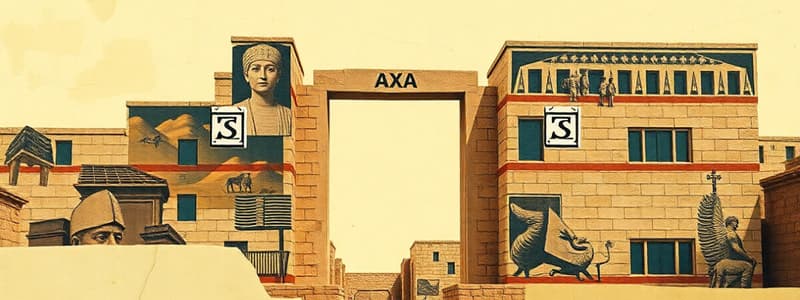Podcast
Questions and Answers
The region known as Mesopotamia is located between the Tigris and Euphrates rivers.
The region known as Mesopotamia is located between the Tigris and Euphrates rivers.
True (A)
The Ishtar gate was built around 575 CE.
The Ishtar gate was built around 575 CE.
False (B)
Sumer was the northernmost region of the Mesopotamian civilization.
Sumer was the northernmost region of the Mesopotamian civilization.
False (B)
The Mesopotamian civilization lasted from about 3500 BCE to 500 BCE.
The Mesopotamian civilization lasted from about 3500 BCE to 500 BCE.
City-states in Mesopotamia were independent and often engaged in battles for resources.
City-states in Mesopotamia were independent and often engaged in battles for resources.
Ziggurats served as both temples and administrative centers in Mesopotamian city-states.
Ziggurats served as both temples and administrative centers in Mesopotamian city-states.
Cyrus of Persia conquered the Mesopotamian civilization around 250 BCE.
Cyrus of Persia conquered the Mesopotamian civilization around 250 BCE.
Assyria was located in the southwestern region of Mesopotamia.
Assyria was located in the southwestern region of Mesopotamia.
The king was regarded as the most powerful person in Mesopotamian society, acting as god's representative.
The king was regarded as the most powerful person in Mesopotamian society, acting as god's representative.
The initial rulers of the cities were primarily known as merchants.
The initial rulers of the cities were primarily known as merchants.
The use of fired bricks in construction was an early development in Mesopotamia, following the use of mud and reeds.
The use of fired bricks in construction was an early development in Mesopotamia, following the use of mud and reeds.
All free citizens in Mesopotamia were required to serve in the military.
All free citizens in Mesopotamia were required to serve in the military.
Agriculture in Mesopotamia relied heavily on seasonal rainfall for irrigation.
Agriculture in Mesopotamia relied heavily on seasonal rainfall for irrigation.
The canals built in Mesopotamia were used for both irrigation and navigation.
The canals built in Mesopotamia were used for both irrigation and navigation.
The king's position was solely hereditary, passed down to his eldest son.
The king's position was solely hereditary, passed down to his eldest son.
Merchants from Mesopotamia primarily traded with the Americas.
Merchants from Mesopotamia primarily traded with the Americas.
Timber and luxury goods were brought from India to Mesopotamia as part of trade.
Timber and luxury goods were brought from India to Mesopotamia as part of trade.
The ox-drawn plough was one of the inventions that aided agriculture in Mesopotamia.
The ox-drawn plough was one of the inventions that aided agriculture in Mesopotamia.
Flashcards are hidden until you start studying
Study Notes
Geography of Mesopotamia
- Mesopotamia means "the land between two rivers," situated between the Tigris and Euphrates rivers, flowing from Turkey to the Persian Gulf.
- Bordered by the Arabian Desert to the west and Iranian mountains to the east.
Historical Context
- Mesopotamian civilization dates back to around 3500 BCE and lasted until about 500 BCE.
- The civilization is known as the "Civilization of the Crescent," flourishing in the fertile crescent from the Persian Gulf to the Mediterranean Sea.
Regions of Mesopotamia
- The southern region, Sumer, was the heart of the civilization, while Babylonia occupied the north, and Akkad was in the central region.
- Assyria was located in the northeast highlands.
- Sumerians initially ruled the civilization, later succeeded by Babylonians and Assyrians, who adopted Mesopotamian customs.
City-States Structure
- Mesopotamia was comprised of city-states, each functioning as an independent political unit.
- Major cities included Babylon, Uruk, Eridu, Lagash, and Ur, each controlling a territory of hundreds of square kilometers.
- City-states frequently battled for resources and power while facing threats from nomadic tribes.
Urban Design
- Cities featured a sacred area with a ziggurat, a temple tower made of sunbaked bricks, built on an artificial hill.
- The ziggurat served as both a religious center and an administrative hub for the city.
- Urban planning was poor, with narrow, messy streets and houses often constructed from mud, reeds, and palm trees.
Social Structure
- Society was hierarchically divided: the king held the highest position, seen as a divine representative.
- Priests held significant power and were the original rulers of the cities.
- Scribes and officers were next, followed by merchants and craftsmen.
- The lowest class consisted of peasants and slaves, many of whom were prisoners of war.
Role of the King
- Kings were once "priest kings," without hereditary succession, responsible for city defense, infrastructure, irrigation, and justice.
- Over time, kings came to be viewed as divine authority.
Economy and Occupations
- Agriculture was the foundation of the economy, with crops including wheat, barley, fruits, and vegetables.
- Advanced irrigation systems, involving canals for perennial water supply, were essential due to sparse rainfall.
- Inventions like the ox-drawn plough and wheeled carts were pivotal for agricultural development.
Trade Practices
- Extensive trade networks connected Mesopotamia with foreign regions, involving routes to the Mediterranean and eastern Africa.
- Key exports included grain, wool, and textiles; imports consisted of copper, lead, timber, luxury goods like ivory and pearls, and silks from India.
- Mesopotamian seals found in the Indus Valley highlight the thriving trade between the two civilizations.
Studying That Suits You
Use AI to generate personalized quizzes and flashcards to suit your learning preferences.



